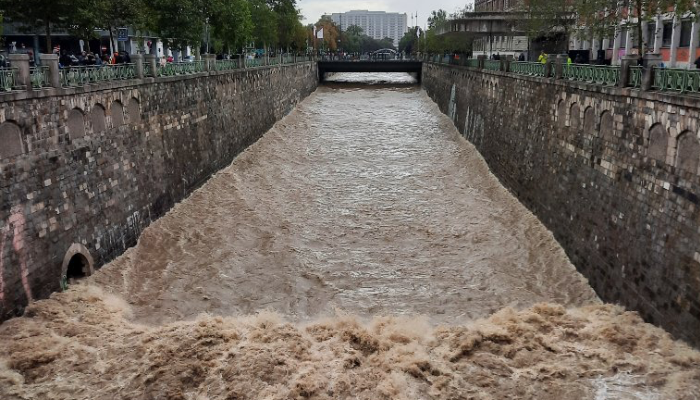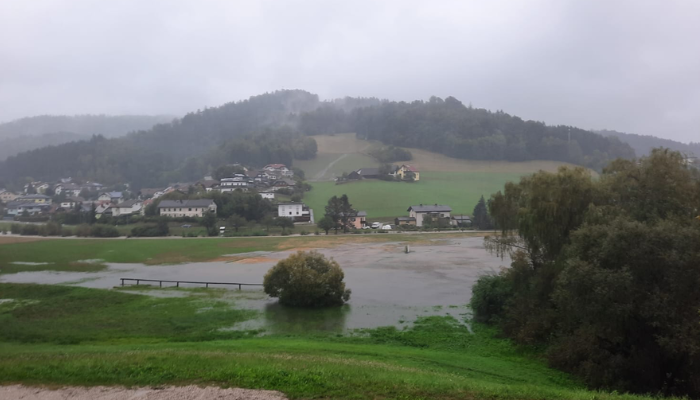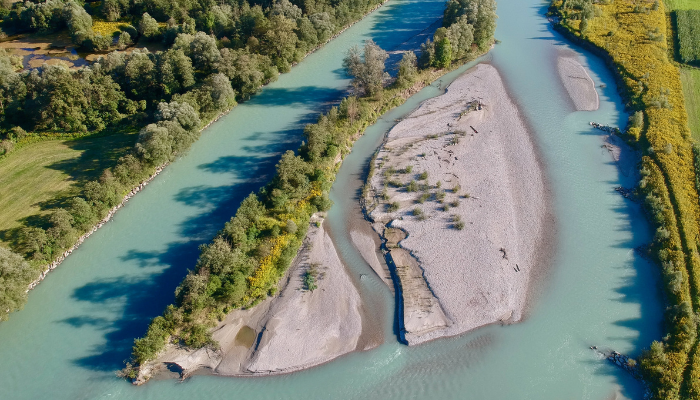
This blog post is co-published with the Hydrology Division (HS).
Storm Boris is the latest in a series of deluges during one of Europe’s most flood-prone periods in 500 years, yet Vienna managed to avoid major damage. The city’s preparations may offer valuable lessons for other urban areas facing similar challenges.
Dealing with record rainfall: September 2024 in Vienna
When record rainfall hit Vienna on September 15, the impact was severe: submerged roads, evacuated homes, and a tranquil stream turned into a torrent. Over five days, the city received five times its typical September rainfall, but locals reported only ten minor injuries and 15 evacuations, thanks to Vienna’s effective flood management system.
In recent decades, Austria has invested heavily in flood protection, particularly after the devastating floods of 2002 and 2013.
The city’s flood defense system, developed in the 1870s and 1970s, is designed to handle a discharge of 14,000 cubic meters per second – far above the 10,000 cubic meters per second during the recent storm. Key components include the New Danube flood control channel and Danube Island, which help manage excess water.

A view of the Old and the New Danube, with the Danube Island in the middle. © C. Orieschnig
Normally, the New Danube is sealed off by weirs, creating a lake. The weirs are opened before an anticipated flood, allowing the channel to accommodate incoming water for several days, alleviating pressure on the main river, the Danube.
Despite the city’s defenses, minor flooding occurred, with the Wienfluss, a smaller river in Vienna, overflowing slightly and threatening underground train tracks and disrupting public transport.

Wenn der Wienfluss zum Wien-🌊 wird#wien #Wienfluss #Hochwasser pic.twitter.com/I6vXoWfdAx
— J. (@j_josb) September 15, 2024
Damage reduction through flood protection and forecasts
Nationwide, Austria invests around €60 million annually in flood protection, significantly reducing damages. Following the 2002 flood, which caused €3 billion in damages, the 2013 flood’s impact fell to about €0.9 billion due to improved measures.
However, challenges persist as urbanization reduces floodplains, increasing risks despite existing protections. This “levee effect” (1) leads residents to underestimate flooding risks, making floodplain settlements more attractive.
Globally, around 2 billion people live on floodplains, and awareness of flooding risks often fades over time. In Austria, precise forecasts and flood management drills have saved lives during the recent flood, not only in Vienna but across the country. Thorough preparation is essential for effective flood management.
Furthermore, accurate forecasts also guided decisions on where dams faced breach risks and where evacuations were necessary, particularly in Lower Austria, which was severely affected by Storm Boris.
The flood forecasting system, developed by the Vienna University of Technology (2), worked really well during the flood. In St. Pölten, rainfall totaled 350 mm (350 liters per square meter) over three days, nearly double the 100-year rainfall.
Consequently, some small streams in Lower Austria reached peak flows three times the 100-year flood level. For instance, the Perschling, a small stream near St. Pölten, had a peak flow of 276 m³/s from a catchment area of just 55 km², compared to a 100-year flood benchmark of 108 m³/s and the highest recorded flood of 102 m³/s.

Flooding in a village at the border between Lower and Upper Austria. © T. Kaiselgruber.
Despite experiencing almost no rainfall in August resulting in dry soils, the extreme precipitation led to dramatic streamflows in local streams, causing significant damage, particularly to numerous basements. The mud carried by the floodwaters contributed to this destruction.
Assessing the effectiveness of nature-based solutions
The 2024 flood illustrates what kind of flood protection can be effective: retention basins for the smaller streams and levees for the larger streams. But these only work up to their protection level. Once the floods exceed this protection level, evacuation is needed.
The September flood also illustrates an argument that has been hotly discussed in Europe in 2024: Nature-based solutions aimed at reducing flood risk. These replicate natural processes and include measures such as wetland and river restoration, floodplain reconnection, green roofs and afforestation. They provide ecological and aesthetic benefits, but their effectiveness in water management is more nuanced.

A rehabilitated stretch of the Drava River in the south of Austria. © C. Orieschnig.
Benefits include enhanced groundwater recharge through pervious pavements in urban areas and reduced landslide and avalanche risks via mountain reforestation. While nature-based solutions are often touted as mitigating extreme regional floods, their effectiveness is limited.
The experience from Austria shows that river restoration and green roofs would have had negligible impact on the September 2024 flood, as their additional infiltration capacity is minimal compared to the flood volumes involved in the event (3).
Looking towards the future, learning from past events
Preparedness is essential, as studies show climate change is leading to more intense storms and floods in certain European regions (4). Summer 2024 was one of the hottest on record globally and in Europe, and the Mediterranean Sea reached very high surface temperatures. This unusual warmth enabled Storm Boris to take up more energy and moisture, increasing storm intensity.

Surface water temperature in the Mediterranean at the end of August 2024. GCOM-C/SGLI L3 Sea Surface Temperature (V3) dataset.
Additionally, Northern Europe has experienced increased flooding due to a northward shift in global rainfall patterns, driven by changing pressure systems between the Arctic and equator. The rapid warming of the Arctic, caused by melting ice, reduces reflectivity and increases sunlight absorption, contributing to this trend.
Countries north of the Alps, including Austria, Germany, and France, have seen a rise in flooding over the last 30 years, marking this period as one of the most flood-affected in Europe in the past 500 years (5).
The devastating European floods in 2021, which took more than 200 lives, underscored the urgency for improved preparedness. A German report in 2024 called for clearer warnings with actionable steps, including detailed public response maps and multi-channel communication to broaden outreach. The 2021 flood also illustrates the inadequacy of relying solely on statistical methods for estimating the flood hazard of extreme events; a combination of process-based and statistical approaches is necessary, along with assessments of historical flood data (6).
Flood protection across borders
While Vienna managed the recent flood relatively well, central Europe faced severe destruction, with over 20 lives lost and entire towns evacuated, such as Nysa in Poland. Farmers in Austria incurred significant crop losses, amounting to millions in damages.
Sharing cross-border lessons is vital for European countries to enhance preparedness for extreme weather. A 2023 analysis revealed that 95.5% of historic megafloods could have been anticipated based on past occurrences in similar regions (7). The study emphasized that while megafloods may be rare in specific countries, they are more frequent across Europe, indicating that localized flooding events should be expected.
With one in eight Europeans living in potentially flood-prone areas, models forecasting increased extreme rainfall in Northwestern Europe suggest this trend will likely continue.
References
(1) Viglione, A., G. Di Baldassarre, L. Brandimarte, L. Kuil, G. Carr, J. L. Salinas, A. Scolobig and G. Blöschl (2014) Insights from socio-hydrology modelling on dealing with flood risk – roles of collective memory, risk-taking attitude and trust. Journal of Hydrology, 518, Part A, 71-82.
(2) Nester, T., R. Kirnbauer, D. Gutknecht and G. Blöschl (2011) Climate and catchment controls on the performance of regional flood simulations. Journal of Hydrology, 402, 340-356.
(3) Blöschl, G. (2022) Three hypotheses on changing river flood hazards. Hydrology and Earth System Sciences, 26, 5015-5033.
(4) Blöschl, G., J. Hall et al. (2019). Changing climate both increases and decreases European river floods. Nature, 573 (7772), 108-111.
(5) Blöschl, G., A. Kiss, A. Viglione et al. (2020) Current European flood-rich period exceptional compared with past 500 years. Nature, 583 (7817), 560–566.
(6) Merz R. and G. Blöschl (2008) Flood frequency hydrology: 1. Temporal, spatial, and causal expansion of information. Water Resources Research, 44, W08432.
(7) Bertola, M., G. Blöschl et al. (2023) Megafloods in Europe can be anticipated from observations in hydrologically similar catchments, Nature Geoscience, 16, 982–988.


